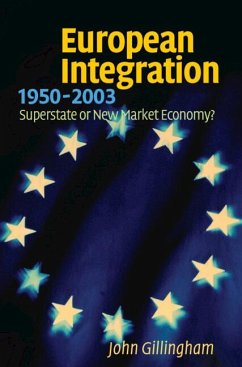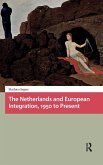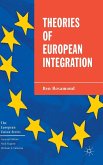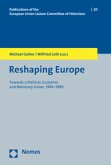John Gillingham
European Integration, 1950-2003
John Gillingham
European Integration, 1950-2003
- Gebundenes Buch
- Merkliste
- Auf die Merkliste
- Bewerten Bewerten
- Teilen
- Produkt teilen
- Produkterinnerung
- Produkterinnerung
Considers European integration from a historical perspective, and speculates on where it might be headed.
Andere Kunden interessierten sich auch für
![The Netherlands and European Integration, 1950 to Present The Netherlands and European Integration, 1950 to Present]() Mathieu SegersThe Netherlands and European Integration, 1950 to Present133,99 €
Mathieu SegersThe Netherlands and European Integration, 1950 to Present133,99 €![Theories of European Integration Theories of European Integration]() Ben RosamondTheories of European Integration170,99 €
Ben RosamondTheories of European Integration170,99 €![Monarchy, Myth, and Material Culture in Germany 1750-1950 Monarchy, Myth, and Material Culture in Germany 1750-1950]() Eva GiloiMonarchy, Myth, and Material Culture in Germany 1750-195053,99 €
Eva GiloiMonarchy, Myth, and Material Culture in Germany 1750-195053,99 €![Women, Children, and the Collective Face of Conflict in Europe, 1900-1950 Women, Children, and the Collective Face of Conflict in Europe, 1900-1950]() Women, Children, and the Collective Face of Conflict in Europe, 1900-195048,99 €
Women, Children, and the Collective Face of Conflict in Europe, 1900-195048,99 €![British Public Opinion and Party Policy Towards European Integration, 1973-2016 British Public Opinion and Party Policy Towards European Integration, 1973-2016]() Stuart SmedleyBritish Public Opinion and Party Policy Towards European Integration, 1973-2016106,99 €
Stuart SmedleyBritish Public Opinion and Party Policy Towards European Integration, 1973-2016106,99 €![Reshaping Europe Reshaping Europe]() Reshaping Europe112,00 €
Reshaping Europe112,00 €![European Elites and Ideas of Empire, 1917-1957 European Elites and Ideas of Empire, 1917-1957]() Dina GusejnovaEuropean Elites and Ideas of Empire, 1917-195747,99 €
Dina GusejnovaEuropean Elites and Ideas of Empire, 1917-195747,99 €-
-
-
Considers European integration from a historical perspective, and speculates on where it might be headed.
Produktdetails
- Produktdetails
- Verlag: Cambridge University Press
- Seitenzahl: 610
- Erscheinungstermin: 4. September 2003
- Englisch
- Abmessung: 235mm x 157mm x 37mm
- Gewicht: 1022g
- ISBN-13: 9780521813174
- ISBN-10: 0521813174
- Artikelnr.: 22475247
- Herstellerkennzeichnung
- Libri GmbH
- Europaallee 1
- 36244 Bad Hersfeld
- gpsr@libri.de
- Verlag: Cambridge University Press
- Seitenzahl: 610
- Erscheinungstermin: 4. September 2003
- Englisch
- Abmessung: 235mm x 157mm x 37mm
- Gewicht: 1022g
- ISBN-13: 9780521813174
- ISBN-10: 0521813174
- Artikelnr.: 22475247
- Herstellerkennzeichnung
- Libri GmbH
- Europaallee 1
- 36244 Bad Hersfeld
- gpsr@libri.de
Part I. A German Solution to Europe's Problems? The Early History of European Communities, 1950-1965: Introduction to part one: a new global setting
1. The liberal project for an integrated Europe
2. The rise and decline of monetarism
3. More or less liberal Europe: the institutional origins of integration
4. All or nothing? The founding of the EEC and the ending of an era, 1958-1966
Conclusion of part one: Needed: a new integration scenario
Part II. From Embedded Liberalism to Liberalism - A Step Forward: European Integration and Regime Change in the 1970s: Introduction to part two: a new European situation
5. Realm of theory to sphere of action
6. Better than muddling through
Conclusion of part two: needed: a new integration theory
Part III. Seeking the New Horizon: European Integration from the Single European Act to the Maastricht Treaty: Introduction to part three: a new realm of possibility
7. Forces of change, forces of resistance
8. Thatcherism, and the reform of Britain
9. The crisis of the welfare state and the challenge of modernization in Europe in the 1980s
10. Maastricht ho! by air, land, or SEA?
11. The Delorean agenda
Conclusion of part three: Needed: a new integration direction
Part IV: A False Dawn? Challenge and Promise in Europe of the 1990s: Introduction to part four: a new global framework
12. Almost a road to nowhere
13. No open and shut cases: member-states and the European community in the 1990s
14. Shrinking enlargement: betrayal of a pledge or new opportunity?
15. The new market economy and Europe's future
Conclusion to part four: Needed: a new European Union?
1. The liberal project for an integrated Europe
2. The rise and decline of monetarism
3. More or less liberal Europe: the institutional origins of integration
4. All or nothing? The founding of the EEC and the ending of an era, 1958-1966
Conclusion of part one: Needed: a new integration scenario
Part II. From Embedded Liberalism to Liberalism - A Step Forward: European Integration and Regime Change in the 1970s: Introduction to part two: a new European situation
5. Realm of theory to sphere of action
6. Better than muddling through
Conclusion of part two: needed: a new integration theory
Part III. Seeking the New Horizon: European Integration from the Single European Act to the Maastricht Treaty: Introduction to part three: a new realm of possibility
7. Forces of change, forces of resistance
8. Thatcherism, and the reform of Britain
9. The crisis of the welfare state and the challenge of modernization in Europe in the 1980s
10. Maastricht ho! by air, land, or SEA?
11. The Delorean agenda
Conclusion of part three: Needed: a new integration direction
Part IV: A False Dawn? Challenge and Promise in Europe of the 1990s: Introduction to part four: a new global framework
12. Almost a road to nowhere
13. No open and shut cases: member-states and the European community in the 1990s
14. Shrinking enlargement: betrayal of a pledge or new opportunity?
15. The new market economy and Europe's future
Conclusion to part four: Needed: a new European Union?
Part I. A German Solution to Europe's Problems? The Early History of European Communities, 1950-1965: Introduction to part one: a new global setting; 1. The liberal project for an integrated Europe; 2. The rise and decline of monetarism; 3. More or less liberal Europe: the institutional origins of integration; 4. All or nothing? The founding of the EEC and the ending of an era, 1958-1966; Conclusion of part one: Needed: a new integration scenario; Part II. From Embedded Liberalism to Liberalism - A Step Forward: European Integration and Regime Change in the 1970s: Introduction to part two: a new European situation; 5. Realm of theory to sphere of action; 6. Better than muddling through; Conclusion of part two: needed: a new integration theory; Part III. Seeking the New Horizon: European Integration from the Single European Act to the Maastricht Treaty: Introduction to part three: a new realm of possibility; 7. Forces of change, forces of resistance; 8. Thatcherism, and the reform of Britain; 9. The crisis of the welfare state and the challenge of modernization in Europe in the 1980s; 10. Maastricht ho! by air, land, or SEA?; 11. The Delorean agenda; Conclusion of part three: Needed: a new integration direction; Part IV: A False Dawn? Challenge and Promise in Europe of the 1990s: Introduction to part four: a new global framework; 12. Almost a road to nowhere; 13. No open and shut cases: member-states and the European community in the 1990s; 14. Shrinking enlargement: betrayal of a pledge or new opportunity?; 15. The new market economy and Europe's future; Conclusion to part four: Needed: a new European Union?
Part I. A German Solution to Europe's Problems? The Early History of European Communities, 1950-1965: Introduction to part one: a new global setting
1. The liberal project for an integrated Europe
2. The rise and decline of monetarism
3. More or less liberal Europe: the institutional origins of integration
4. All or nothing? The founding of the EEC and the ending of an era, 1958-1966
Conclusion of part one: Needed: a new integration scenario
Part II. From Embedded Liberalism to Liberalism - A Step Forward: European Integration and Regime Change in the 1970s: Introduction to part two: a new European situation
5. Realm of theory to sphere of action
6. Better than muddling through
Conclusion of part two: needed: a new integration theory
Part III. Seeking the New Horizon: European Integration from the Single European Act to the Maastricht Treaty: Introduction to part three: a new realm of possibility
7. Forces of change, forces of resistance
8. Thatcherism, and the reform of Britain
9. The crisis of the welfare state and the challenge of modernization in Europe in the 1980s
10. Maastricht ho! by air, land, or SEA?
11. The Delorean agenda
Conclusion of part three: Needed: a new integration direction
Part IV: A False Dawn? Challenge and Promise in Europe of the 1990s: Introduction to part four: a new global framework
12. Almost a road to nowhere
13. No open and shut cases: member-states and the European community in the 1990s
14. Shrinking enlargement: betrayal of a pledge or new opportunity?
15. The new market economy and Europe's future
Conclusion to part four: Needed: a new European Union?
1. The liberal project for an integrated Europe
2. The rise and decline of monetarism
3. More or less liberal Europe: the institutional origins of integration
4. All or nothing? The founding of the EEC and the ending of an era, 1958-1966
Conclusion of part one: Needed: a new integration scenario
Part II. From Embedded Liberalism to Liberalism - A Step Forward: European Integration and Regime Change in the 1970s: Introduction to part two: a new European situation
5. Realm of theory to sphere of action
6. Better than muddling through
Conclusion of part two: needed: a new integration theory
Part III. Seeking the New Horizon: European Integration from the Single European Act to the Maastricht Treaty: Introduction to part three: a new realm of possibility
7. Forces of change, forces of resistance
8. Thatcherism, and the reform of Britain
9. The crisis of the welfare state and the challenge of modernization in Europe in the 1980s
10. Maastricht ho! by air, land, or SEA?
11. The Delorean agenda
Conclusion of part three: Needed: a new integration direction
Part IV: A False Dawn? Challenge and Promise in Europe of the 1990s: Introduction to part four: a new global framework
12. Almost a road to nowhere
13. No open and shut cases: member-states and the European community in the 1990s
14. Shrinking enlargement: betrayal of a pledge or new opportunity?
15. The new market economy and Europe's future
Conclusion to part four: Needed: a new European Union?
Part I. A German Solution to Europe's Problems? The Early History of European Communities, 1950-1965: Introduction to part one: a new global setting; 1. The liberal project for an integrated Europe; 2. The rise and decline of monetarism; 3. More or less liberal Europe: the institutional origins of integration; 4. All or nothing? The founding of the EEC and the ending of an era, 1958-1966; Conclusion of part one: Needed: a new integration scenario; Part II. From Embedded Liberalism to Liberalism - A Step Forward: European Integration and Regime Change in the 1970s: Introduction to part two: a new European situation; 5. Realm of theory to sphere of action; 6. Better than muddling through; Conclusion of part two: needed: a new integration theory; Part III. Seeking the New Horizon: European Integration from the Single European Act to the Maastricht Treaty: Introduction to part three: a new realm of possibility; 7. Forces of change, forces of resistance; 8. Thatcherism, and the reform of Britain; 9. The crisis of the welfare state and the challenge of modernization in Europe in the 1980s; 10. Maastricht ho! by air, land, or SEA?; 11. The Delorean agenda; Conclusion of part three: Needed: a new integration direction; Part IV: A False Dawn? Challenge and Promise in Europe of the 1990s: Introduction to part four: a new global framework; 12. Almost a road to nowhere; 13. No open and shut cases: member-states and the European community in the 1990s; 14. Shrinking enlargement: betrayal of a pledge or new opportunity?; 15. The new market economy and Europe's future; Conclusion to part four: Needed: a new European Union?
'John Gillingham's fascinating history of European integration brings out the shifts of gears, changes of direction and divergent impulses that brought the European Union to its present established but contested shape as the triumph of market over state. Gillingham wanted his book to 'trumpet like an elephant', and it does. To extend his metaphor, it gores any number of sacred cows, from the myths of the Founding Fathers and of American benevolence to the European social model. It will stimulate lively and constructive debate.' Robert O. Paxton, Columbia University









